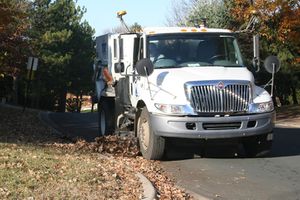
Difference between revisions of "Street sweeping"
m |
m |
||
| Line 1: | Line 1: | ||
| + | == == | ||
| + | |||
[[File:Street-sweeping.jpg|300px|thumb|alt=image of street sweeper|<font size=3>Image courtesy Sarah Hobbie, University of Minnesota</font size>]] | [[File:Street-sweeping.jpg|300px|thumb|alt=image of street sweeper|<font size=3>Image courtesy Sarah Hobbie, University of Minnesota</font size>]] | ||
Revision as of 14:06, 5 March 2021
- Overview of street sweeping
- Recommended street sweeping practices for water quality purposes - Coming in summer, 2021
- Pollutant removal associated with street sweeping
- Methods for calculating pollutant reductions (credits) for street sweeping
- Calculating pollutant removal credits for street sweeping - Coming spring, 2021
- Tool for calculating phosphorus removal from street sweeping - Coming in spring, 2021
- Methods for sampling street sweeping material - Standard Operating Procedures
- Guidance for incorporating street sweeping into the Minimal Impact Design Standards Calculator and MPCA’s Simple Estimator - Coming in summer, 2021
- Managing street sweepings
- Case studies for street sweeping
- Links for street sweeping
- Supporting information
Survey of street sweeping practices
The MPCA conducted a survey of cities to determine their street sweeping practices, their interest in a street sweeping credit, and their ability to implement different methods for crediting sweeping. We have not yet fully analyzed the data, but some general conclusions include the following.
- 75 cities responded to the survey and indicated they operate a sweeping program. This was a response rate of close to 50 percent. The responses were distributed geographically across the state and covered a wide range of city sizes (large to small).
- About 78 percent indicated they would be likely to participate in a crediting program
- All but 7 cities can track sweeping information, but 66 percent said they cannot relate material collected to a specific geographic area. This is a question we likely will follow-up with, since being able to relate material to a geographic location is potentially a way of targeting sweeping efforts.
- Most cities estimate volume or mass of material collected, but few measure volume or mass or have the ability to measure dry weight of material collected
- Most cities sweep quarterly or less and most do not specifically sweep in response to fall leave drop
The summary information can be found here.
Related pages
- Trees
- Phosphorus
- Total Suspended Solids (TSS) in stormwater
- Street sweeping for trees
- Neat websites and articles for trees
- Guidance for managing sediment and wastes collected by pretreatment practices: Note - this page contains some information on disposal of material collected in pretreatment practices, include information on street sweepings
